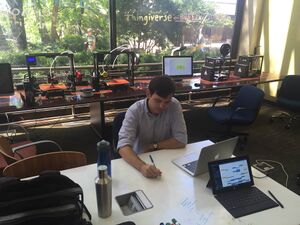Resource:How to measure, document and report usage of equipment in your makerspace
<parsererror style="display: block; white-space: pre; border: 2px solid #c77; padding: 0 1em 0 1em; margin: 1em; background-color: #fdd; color: black">
Contents
Introduction
We interviewed Forrest Satterfield, a student from the University of Alabama at Birmingham, who is an active advocate for promoting innovative culture
through creating platforms for students to gain easier access to tools that support their innovative entrepreneurial ventures. As a result, he and his peers created a makerspace at the campus' library. During the interview, Forrest provided insights on how to start a makerspace, how to get funding for it, and most importantly, how to operate the makerspace to ensure that equipment used in makerspace are properly managed and taken care of.
How was the makerspace created?
Although there was no proven evidence for a need of a makerspace, Forrest realizes how much more potential students could do if there are makerspace tools available for students.
How to secure a space for a makerspace?
When Forrest and his peers have the idea of creating a makerspace platform, they did not immediately get a space. Instead, they started by occupying an area at the campus library. They would build prototypes in the public area at the library using the pieces of equipment that they begin to bring in. As more people occupied the space, the demand for a private space increase when there was not having enough space for pieces of equipment or materials. Ultimately, Forrest and his peers, along with equipment users, were granted to have space entirely dedicated to a makerspace room by having a divider built between the makerspace and the larger room of the library.
Once you secure a space, use the layout to dictate the actions you want your users to make. People will respond and act according to the layout of the room. Example: If it is a theater setting, people will treat it as a theater and will sit down. If you want an interactive space, you may want less chairs.
No Funds? No problem.
Identify what is needed from your clients by interviewing them. If they are students, interview the students to see if there is need for a Makerspace and what equipment would be needed. This way you can focus on the most important factors of the space.When interviewing them, remember you are trying to empathize with them and figure out what their biggest need is. For example, money and funding can solve the problem, but that does not mean finance is the root issue.
When it comes down to funding, what is the best way to receive it from your school? It is better to ask for help, rather than money. Your admin and faculty would be much more open to responding to help than a request for funding. Be patient, and eventually the funding will be available.
How to measure usage of equipment?
Lorem ipsum
How to document usage of equipment?
Lorem ipsum
How to report usage of equipment?
Lorem ipsum
